Wednesday, January 23, 2008, 06:15 PM
- Models
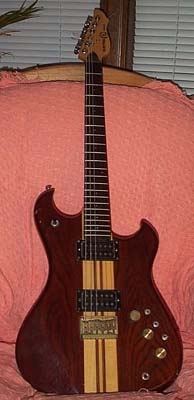
Bolt neck double cutaway with laminated ash, maple and walnut strip body, maple neck, chrome hardware, brass nut, brass hardtail bridge and dual humbuckers with toggle switches for coil tap and phase reverse, brass knobs for volume, preamp gain, and tone control.
When the Electra Phoenix first appeared in late 1980, there were the standard 2- and 3-pickup models with pickguards, and there was also a deluxe model with a body of dark brown ash with laminated strips of maple and walnut at the center. No doubt one of these would be ordered as premium display attractors but the lower priced models were what sold the most.
The laminated body follows the identical stripe pattern with many other Matsumoku-made guitars of the time, including the Aria Pro, Westone, Washburn and Skylark models.
Ironically, the laminated body is sometimes mistaken for an imitation of a neck-through guitar, which it is not. Excellent bolt-neck that it is, it need not pretend. Matsumoku had raised the art of making composite chunks of hardwood out of smaller to a fine degree, and these laminated bodies are made with all the care and attention of a flagship model.
In addition to its beautiful body, the X150 also sported a most exotic feature for the time: onboard active EQ. The third toggle switch turned on the EQ; when this was on the middle knob boosted the output, and the third knob would had a center detent and would boost treble when turned clockwise and bass when turned counterclockwise. When EQ was off, the tone knob worked like a conventional tone knob.
Was active EQ really a useful feature? Gibson had asked the same question with the Artist series, which it doomed by associating with the strange and unpopular RD series. It can be useful for some players- certainly a preamp is one way of shaping distortion. But for distortion you want to boost midtones, not high and low. Active EQ tends to be most useful for players who use clean tones, especially those who, like electric acoustic players, tend to be plugging into weird PA systems not designed for guitar, or in weird room situations.
Today we have to remember that making effect devices easily available to consumers was a fairly new innovation. There were some hairy fuzz pedals, and wahs, and giants like Hendrix and Page had them, but there was not the plethora of devices we have today. So having active EQ onboard, like the MPC guitars which carried onboard effects, was a really interesting experimental way to apply the electronics. It was a different direction than we see today, one which certainly put controls at the usersí fingertips. The question remains whether the average player really wants that much control.
The X150 is one of the finest of the Electra Phoenix family, its exotic wiring and excellent tone matched by the fact that flagship models, especially in the early 80ís, seemed to have been given extra hands-on attention, their lines and setup are generally especially good among the Phoenixes.
From the 1981 pricelist:
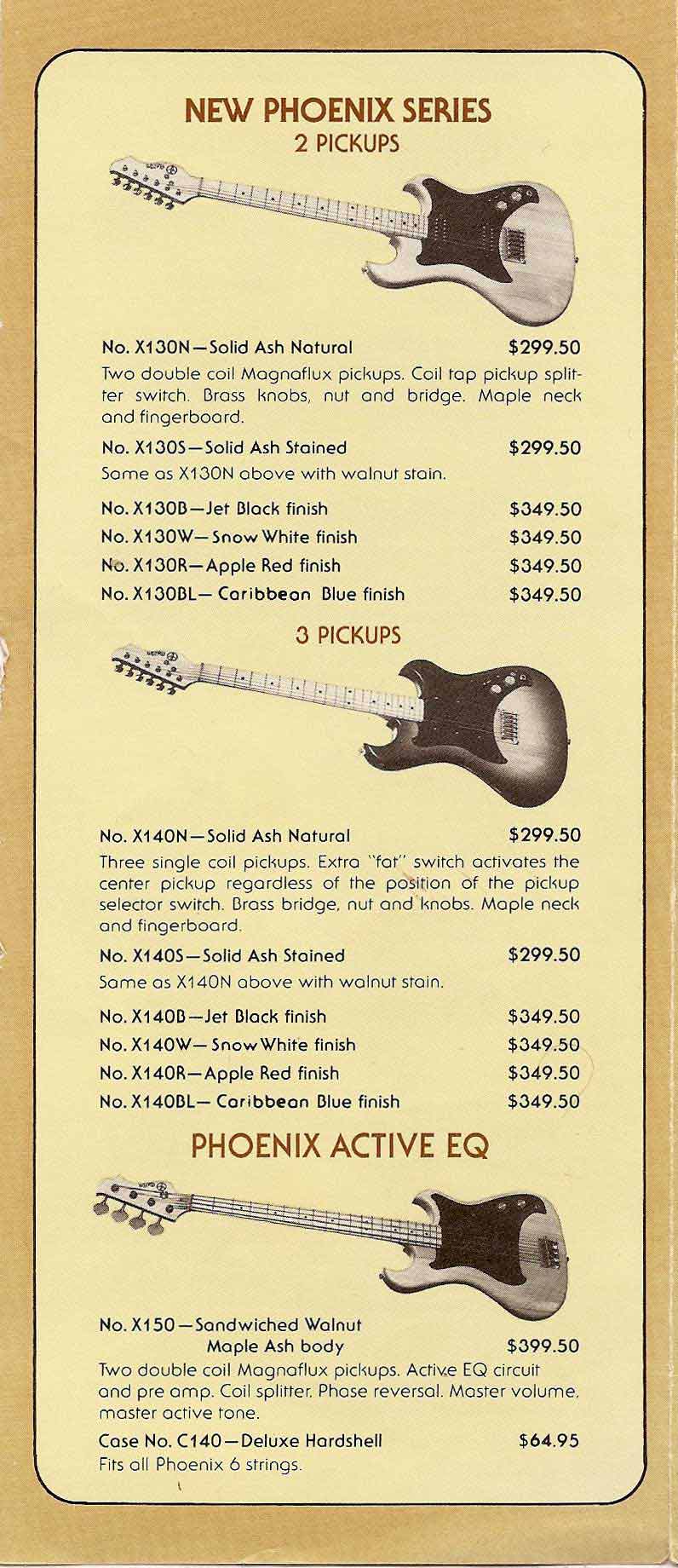
permalink
| related link
Wednesday, January 23, 2008, 06:10 PM
- Models
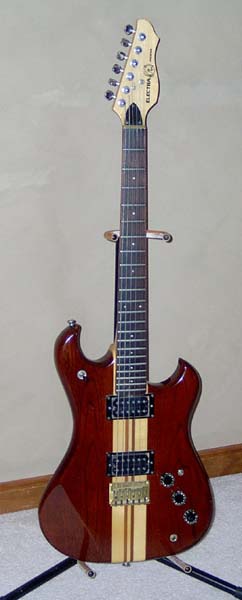
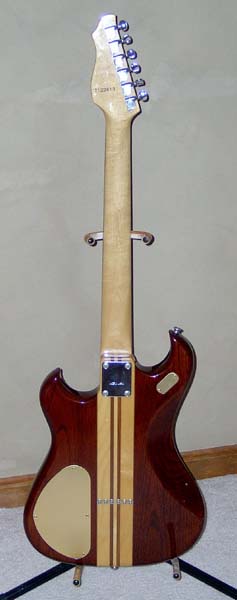
Bolt neck double cutaway with laminated ash, maple and walnut strip body, maple neck, chrome hardware, brass nut, brass hardtail bridge and dual humbuckers with toggle switch for coil tap, brass knobs.
When the Electra Phoenix first appeared in late 1980, there were the standard 2- and 3-pickup models with pickguards, and there were also two deluxe models with bodies of dark brown ash with laminated strips of maple and walnut at the center. No doubt one or two of these would be ordered as premium display attractors but the lower priced models were what sold the most.
The laminated body follows the identical stripe pattern with many other Matsumoku-made guitars of the time, including Aria Pro, Westone, Washburn and Skylark models.
Ironically, the laminated body is sometimes mistaken for an imitation of a neck-through guitar, which it is not. Excellent bolt-neck that it is, it need not pretend. Matsumoku had raised the art of making composite chunks of hardwood out of smaller to a fine degree, and these laminated bodies are made with all the care and attention of a flagship model.
The X149 is identical to the X150 in every respect except that it does not have powered EQ. The tone knob is a conventional tone knob, and it has only one toggle switch, for coil tap. It can also be recognized by the lack of a brass battery cover at the base of the back, which powers the EQ in the X150.
The X149 appears to be the rarer of the two deluxe models, probably because if youíre ordering a deluxe model, why omit the fancy electronics? Yet at the time onboard powered EQ was exotic- (at the time Fender had not even upgraded strat 3-way to 5-way switches yet- that was strictly custom) So itís not hard to imagine a few conservative music store owners who had tried out powered EQ, or hadnít, and found it useless. So offering a version without the powered EQ seems reasonable, if not popular.
Today the X149 is one of the finest of the Electra Phoenix family, its familiar controls and excellent tone matched by the fact that flagship models, especially in the early 80ís, seemed to have been given extra hands-on attention, their lines and setup are generally especially good among the Phoenixes.
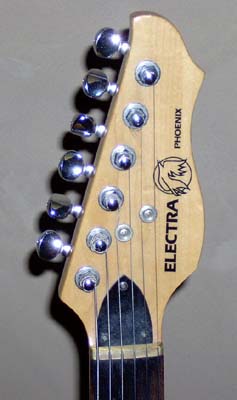
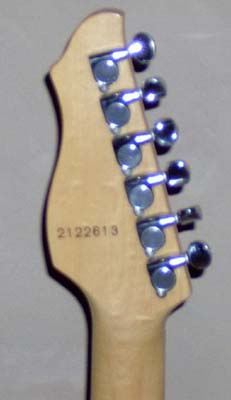
Wednesday, January 23, 2008, 06:06 PM
- Models
Bolt neck double cutaway with ash body, maple neck, chrome hardware, and three single coil pickups with 3-way selector and fat switch (middle on), brass knobs.
First Series:
X145R (S-S-S)(red metalflake)
X145B (S-S-S)(blue metalflake)
Second series:
X145VS (S-S-S)(vintage sunburst)
The first series was a deluxe version of the X130 with special metallic paint and black pickguard like the X130, brass nut, trem bridge, brass knobs.
Most had a brass '1982 commemorative anniversary' plate on the back of the headstock with an additional serial number.
The second series was almost a different model entirely- no pickguard, it had pickups mounted flush against the body, like all Phoenix models to follow. It was the only model in all the Electra Phoenix/ Westone Spectrum series to be available in a sunburst finish.
Wednesday, January 23, 2008, 05:57 PM
- Models
Bolt neck double cutaway with maple body, maple neck, chrome hardware, graphite nut, Bendmaster FT trem bridge with locking nut, and and dual humbuckers with coil tap toggle switch with 3-way selector and pull-switch knobs for coil tap and phase reverse, brass knobs.X140BK (H-H) (black)
X140SW (H-H) (snow white)
X140RD (H-H) (red)
The Spectrum DX was introduced in 1985 with the new line of Electra Phoenix-based models renamed Westone Spectrum. Unlike the Phoenix models which came in a bewildering variety with mysterious code numbers, the Spectrum models were clearly divided into recognizable price and feature ranges: ST (standard) was the budget line, DX (deluxe) was a slightly higher priced line which offered upgraded hardware but was still lower in price than the LX (pro) series which was a continuation of the classic X189 (H-S-H). The DX gave an alternative for those who wanted premium quality at the lowest price possible.
The DX succeeds at all that and continues to be one of the best bang-for-the-buck models, going for low prices yet offering a great variety of tonal range and the great neck and pickups the Phoenix and Spectrum were known for. The polyurethane finish of these models is nearly indestructible, so they tend to stay in good shape.
X140 is one of the few model numbers to be used by two different models- confusingly the number returned to use in 1985 after the Electra Phoenix had been renamed the Westone Spectrum. The Spectrum DX was numbered X140, but instead of being an updated (S-S-S), the DX was really an (H-H) like the X135 with the upgraded hardware of an X189.
Wednesday, January 23, 2008, 05:47 PM
- Models
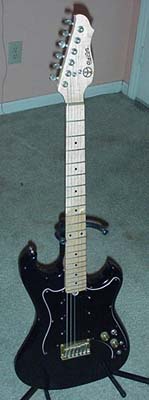
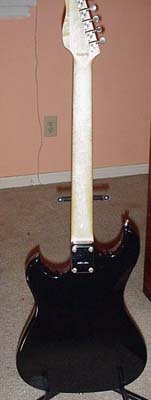
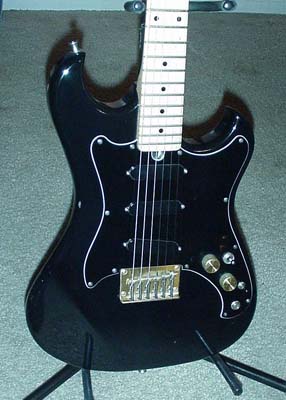
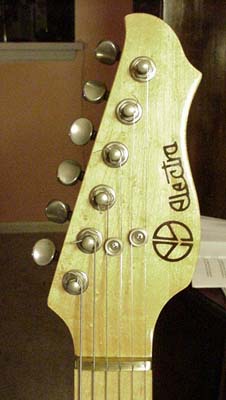
Bolt neck double cutaway with ash body, maple neck, black pickguard, chrome hardware, brass nut, brass hardtail bridge with strings through body, and three single coil pickups with 3-way selector and fat switch (middle on), brass knobs.
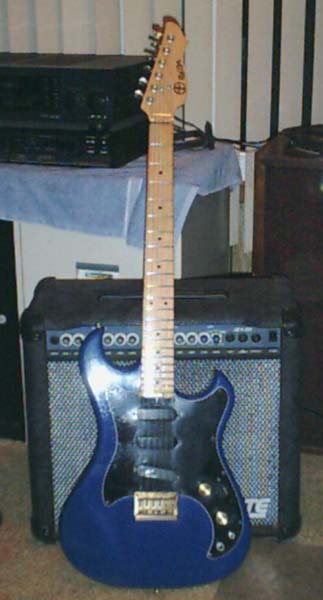
Standard models:
X140N (S-S-S)(natural)
X140S (S-S-S)(walnut stain)
X140B (S-S-S)(black)
Custom models had premium tuners, Canadian rock maple bodies:
X140W (S-S-S)(white)
X140R (S-S-S)(red)
X140BL (S-S-S)(blue)
The X140 was one of the first Electra Phoenixes to appear in late 1980. The standard models have wonderfully resonant figured ash bodies, and the brass nut and hardtail string-though bridge add to the great tone.
X140 is one of the few model numbers to be used by two different models- confusingly the number returned to use in 1985 after the Electra Phoenix had been renamed the Westone Spectrum. (The Spectrum DX was numbered X140, but instead of being an updated S-S-S, the DX was really an H-H like the X135 with the upgraded hardware of an X189.)
From the 1981 pricelist:

Back Next






